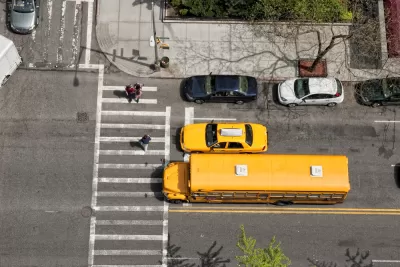Adam Millard-Ball guest blogs about a new article in the Journal of Planning Education and Research.

Guest Blogger: Adam Millard-Ball of the University of California, Santa Cruz.
Fast forward to the year 2050. Autonomous (self-driving) vehicles are the norm. Their original promises: drivers would be freed from a tedious chore, traffic collisions would be a relic of history, and congestion would be all but eliminated as vehicles communicated with each other to smooth out traffic.
In dense, urban centers, however, the reality of autonomous vehicles has transpired somewhat differently. Manhattan, San Francisco, and even downtown Phoenix are gridlocked. Pedestrians move freely throughout the streets, crossing at will. Children play basketball on residential streets.
What caused this new era of pedestrian supremacy? The answer lies in the commendable safety record of autonomous cars. Self-driving systems continuously scan for other road users. In the presence of an unpredictable child, a risk-averse autonomous car slows down and yields. At midblock and unmarked crosswalks, the car—programmed to obey the rules of the road—stops and waits for the pedestrian to cross.
In my new article in the Journal of Planning Education and Research, I use the economic game of "chicken" to help understand the interactions between pedestrians and cars. In the classic version of the game, two daredevil drivers speed toward each other. The winner: the driver who does not “chicken out” and swerve.
A similar game applies to encounters between cars and pedestrians at a crosswalk. On most streets today, pedestrians invariably yield to cars even when they have the right of way. Pedestrians have far more to lose from a collision, and the probability of an inattentive or intoxicated driver is, for most of us, too high to chance.
In a city dominated by autonomous vehicles, however, pedestrians have the upper hand. Provided that sight distances and speeds provide sufficient braking distance, they can cross with impunity. The pedestrian knows that the autonomous vehicle will not be drunk or distracted, and that it will follow the law.
A good way to win at chicken is to behave as a sociopath—one who prefers death to losing, and who will not swerve under any circumstances. Autonomous vehicles are incapable of such behavior. Pedestrians, on the other hand, gain an incentive to act unpredictably. They may just need to step into the street to force the risk-averse car to slow down. The same is true for cyclists, who are empowered to ride in traffic and “take the lane.”
What can planners learn from using game theory to formalize such a thought experiment? First, the safety and law-abiding nature of autonomous vehicles is likely to slow such cars down. It would take long enough to drive across Manhattan at rush hour while obeying all traffic laws to the letter. Now imagine the same experience with pedestrians crossing at will, and bicyclists cutting in front. In dense, urban centers, autonomous vehicles are at a speed disadvantage, and trips may shift to walking and cycling.
Second, most analyses have assumed autonomous vehicles will “play nice” and cooperate with each other. But this assumption may not match optimal private behavior. For example, traffic congestion could be worsened if autonomous vehicles cut in front of each other, safe in the knowledge that the other car will yield and brake.
Or consider the Super Bowl, where each spectator exiting the stadium instructs her autonomous car to time its arrival at the curb to minimize her wait. To achieve this, one option would be for the car to circle the block, creeping slowly along the final block at the minimum possible speed in the hopes that its owner would emerge. For one vehicle to do this would be annoying. Gridlock would result if all 70,000 Super Bowl attendees did the same.
The ultimate impacts of autonomous vehicles depend not only on technological advances and market adoption, but also on how planners and policy makers respond. One approach would be to maintain traffic speeds by eliminating crosswalks, erecting fences between the sidewalk and roadway to corral pedestrians, and stepping up enforcement against jaywalkers.
Alternatively, planners could seize the opportunity to create more pedestrian-oriented streets, and relegate drop-offs to the fringes of urban commercial districts. Paradoxically, autonomous vehicles could usher in a new era of pedestrian supremacy.
This blog post is adapted from Millard-Ball, A., 2016. "Pedestrians, Autonomous Vehicles and Cities." Journal of Planning Education and Research. Open Access Until November 26th, 2016

Depopulation Patterns Get Weird
A recent ranking of “declining” cities heavily features some of the most expensive cities in the country — including New York City and a half-dozen in the San Francisco Bay Area.

California Exodus: Population Drops Below 39 Million
Never mind the 40 million that demographers predicted the Golden State would reach by 2018. The state's population dipped below 39 million to 38.965 million last July, according to Census data released in March, the lowest since 2015.

Chicago to Turn High-Rise Offices into Housing
Four commercial buildings in the Chicago Loop have been approved for redevelopment into housing in a bid to revitalize the city’s downtown post-pandemic.

Google Maps Introduces New Transit, EV Features
It will now be easier to find electric car charging stations and transit options.

Ohio Lawmakers Propose Incentivizing Housing Production
A proposed bill would take a carrot approach to stimulating housing production through a grant program that would reward cities that implement pro-housing policies.

Chicago Awarded $2M Reconnecting Communities Grant
Community advocates say the city’s plan may not do enough to reverse the negative impacts of a major expressway.
City of Costa Mesa
Licking County
Barrett Planning Group LLC
HUD's Office of Policy Development and Research
Mpact Transit + Community
HUD's Office of Policy Development and Research
City of Universal City TX
ULI Northwest Arkansas
Town of Zionsville
Write for Planetizen
Urban Design for Planners 1: Software Tools
This six-course series explores essential urban design concepts using open source software and equips planners with the tools they need to participate fully in the urban design process.
Planning for Universal Design
Learn the tools for implementing Universal Design in planning regulations.



























